Middle East and Africa Diabetes Treatment Market Size
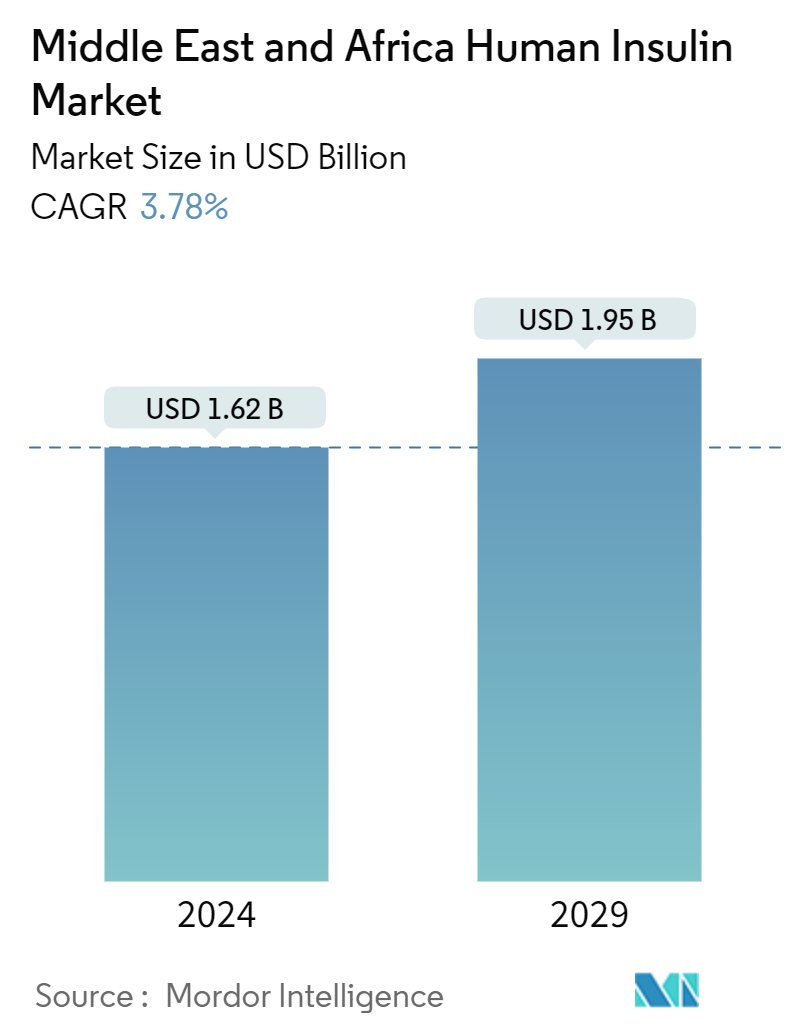
| Study Period | 2019- 2029 |
| Base Year For Estimation | 2023 |
| Forecast Data Period | 2024 - 2029 |
| Market Size (2024) | USD 1.62 Billion |
| Market Size (2029) | USD 1.95 Billion |
| CAGR (2024 - 2029) | 3.78 % |
Major Players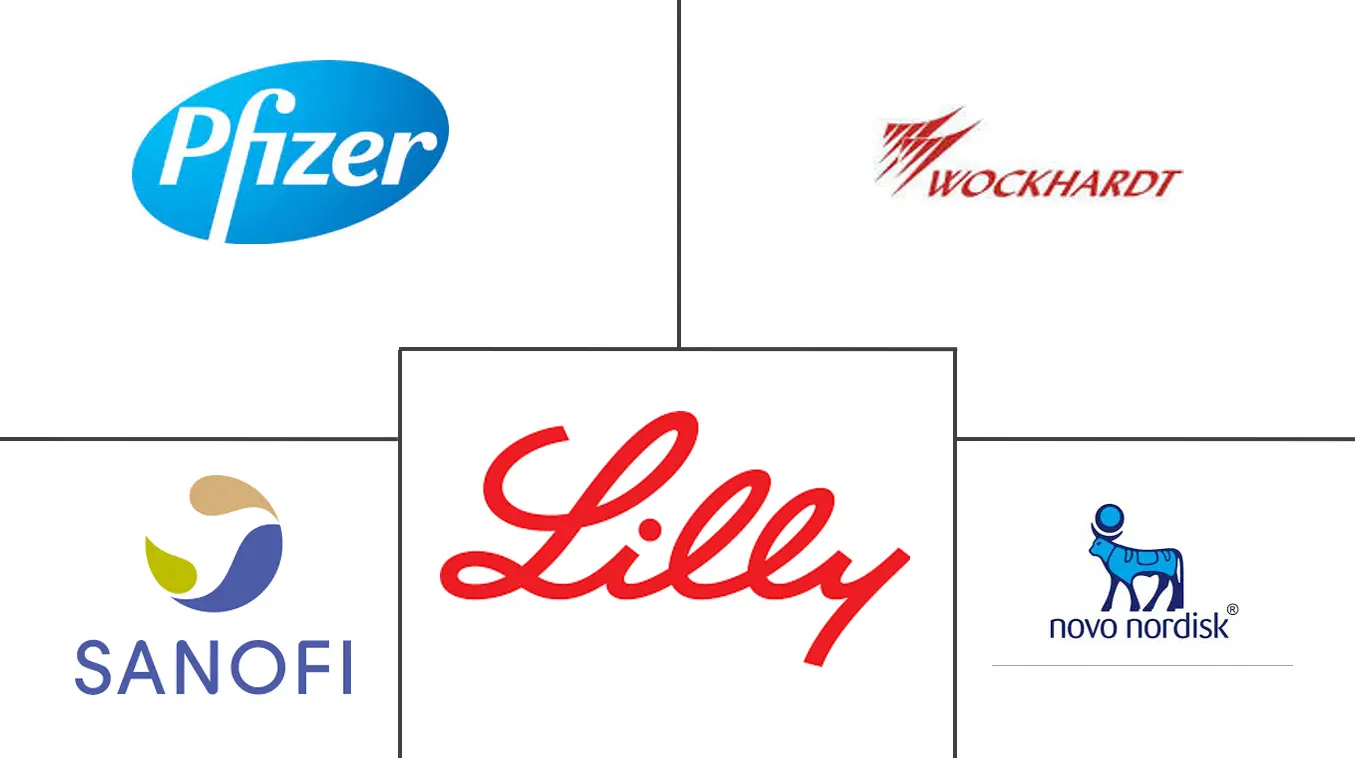
*Disclaimer: Major Players sorted in no particular order |
Need a report that reflects how COVID-19 has impacted this market and its growth?
Middle East and Africa Diabetes Treatment Market Analysis
The Middle East And Africa Human Insulin Market size is estimated at USD 1.62 billion in 2024, and is expected to reach USD 1.95 billion by 2029, growing at a CAGR of 3.78% during the forecast period (2024-2029).
In the Middle-East and Africa, Type 1 diabetes forms approximately 10% of the diabetes conditions, and Type 2 contributes to 90%. Type 1 patients need to take insulin throughout their lives while maintaining a healthy diet and regular physical exercise.
Type 2 patients need to eat healthily, remain physically active, and perform regular tests to check their blood glucose levels. They may also need to take oral medication and insulin to control the glucose levels in their blood. There are many complications associated with diabetes, like diabetic ketoacidosis and non-ketotic hyperosmolar coma. Serious long-term complications include heart disease, stroke, kidney failure, foot ulcers, and damage to the eyes.
The insulin market is experiencing significant growth due to the rapid increase in the diabetes population in the Middle East and Africa region. Diabetes has become a major health concern in these regions, with a rising number of individuals being diagnosed with the disease.
One of the primary factors driving the growth of the insulin market in the Middle East and Africa is the changing lifestyle and dietary habits of the population. Urbanization, sedentary lifestyles, and the adoption of unhealthy diets high in sugar and processed foods have contributed to the rise in diabetes cases. As a result, there is a growing demand for insulin to manage and control blood sugar levels among diabetic patients.
Additionally, the aging population in the Middle East and Africa is another significant factor contributing to the increased demand for insulin. With advancing age, the risk of developing diabetes increases, leading to a larger diabetic population that requires insulin therapy.
As the production of insulin is very complex, there are very few companies in the market that manufacture insulin. Thus, there is high competition between these manufacturers, and they always strive to meet the patient's needs and supply the best-quality insulin.
Middle East and Africa Diabetes Treatment Market Trends
Biosimilar Insulin Segment Holds Highest Market Share in Middle-East and Africa Human Insulin Market.
Biosimilar insulin is highly popular in the Middle East and Africa region because of its low cost as compared to branded insulins. The Middle East and African countries have substantial economic diversity. The per-capita expenditure on diabetes in the region is low, although some countries in the region have managed to modify their healthcare expenditure to include biologic and biosimilar therapies.
The governments of the Middle East and African countries are recognizing the importance of driving biosimilar uptake to create a competitive and sustainable biosimilar market. With no clinically significant differences in efficacy, safety, purity, or potency, several companies are developing biosimilars that are very similar to the reference insulin glargine.
The total diabetes population in the Middle East and Africa has increased by more than 200% over the past few years. Approximately 8% of the diabetic population in the region has type-1 diabetes. The Middle East and Africa were two of the largest markets for these biosimilars in 2022. There is increasing adoption of insulin glargine biosimilars across the Middle East and Africa, which is contributing to the overall growth of the segment.
Several governments are recognizing the importance of driving biosimilar uptake to create a competitive and sustainable biosimilar market. Driven by government initiatives, several companies are developing biosimilars that are highly similar to the reference insulin glargine with no clinically meaningful differences in efficacy, safety, purity, or potency. Developments are expected to help the growth of the insulin biosimilar market during the forecast period.
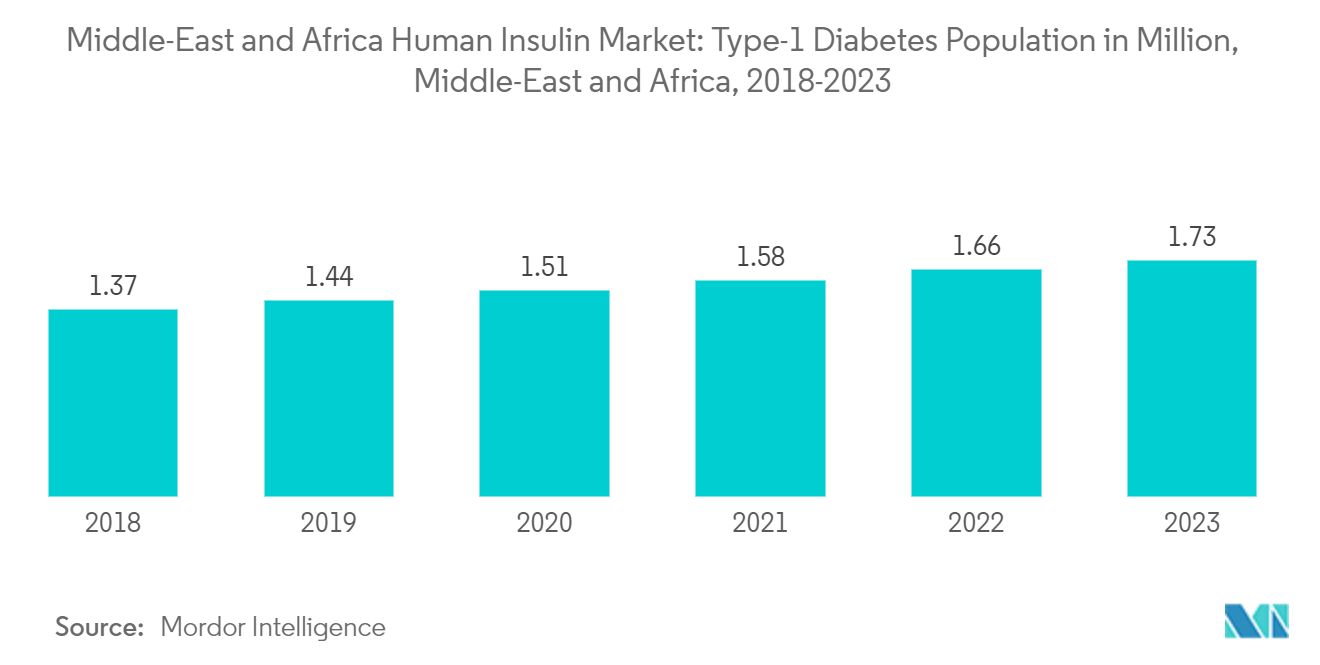
Saudi Arabia Holds Highest Market Share in Middle-East and Africa Insulin Market.
Diabetes is one of the mounting health problems the country is facing. Saudi is ranked among the top three in the Middle East and African countries with the highest prevalence of diabetes. In Saudi Arabia, diabetes mellitus is a condition that is on the rise. In this context, a cross-sectional retrospective study was done to assess Saudi Arabia's non-insulin-dependent diabetic mellitus disease management costs and medicine usage patterns.
According to the WHO, the number of people with diabetes in Saudi Arabia is expected to rise by almost 300% from 890,000 in 2000 to 2,523,000 in 2030. Its prevalence was strongly correlated with energy use, sedentary behavior, and Gross Domestic Product (GDP).
Saudi Arabia, which has the second-highest rate of DM in the Middle East, and seven million and three million people with diabetes and pre-diabetes, respectively, is vulnerable to the worldwide diabetes epidemic. Few studies, however, have looked at the levels of treatment compliance and adherence among diabetic patients living in different parts of Saudi Arabia. According to a study by Ahmed et al., 54.8% of diabetic patients disregarded follow-up schedules, medication instructions, and recommendations for healthy foods, and 45.5% of patients with diabetes skipped follow-up sessions.
Saudi Arabia is aiming to reduce the prevalence of the disease by 10% over the next decade. Several initiatives, including taxing sugary drinks, fitness initiatives, and focusing on preventative care, are being taken up by the government to stem the rising epidemic. The government's focus on combating diabetes and the higher purchasing power of the people in the country may help the market for diabetes drugs, like insulin drugs, during the forecast period.
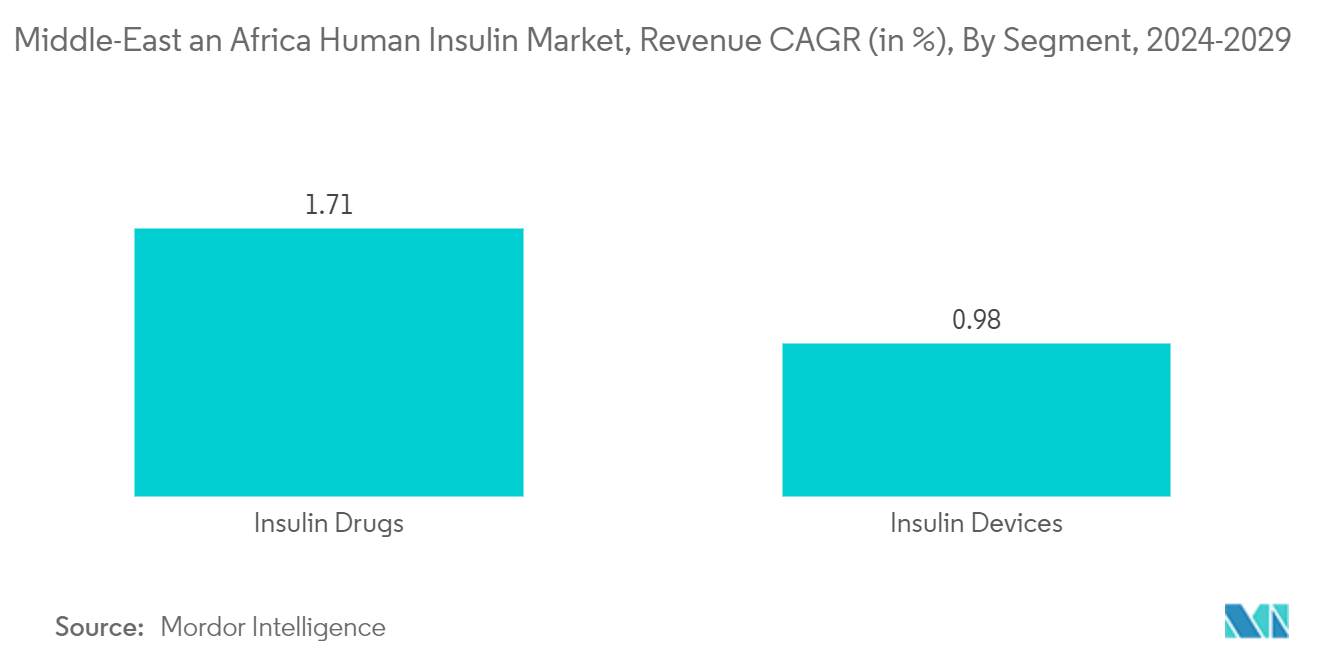
Middle East and Africa Diabetes Treatment Industry Overview
The Middle-East and Africa human insulin market is dominated by Novo Nordisk, Sanofi, and Eli Lilly. However, there are many local players like Biocon, Julphar, Sedico, and Exir, who hold a significant market share.
Middle East and Africa Diabetes Treatment Market Leaders
Novo Nordisk
Sanofi
Eli lilly
Wockhardt
Pfizer
*Disclaimer: Major Players sorted in no particular order
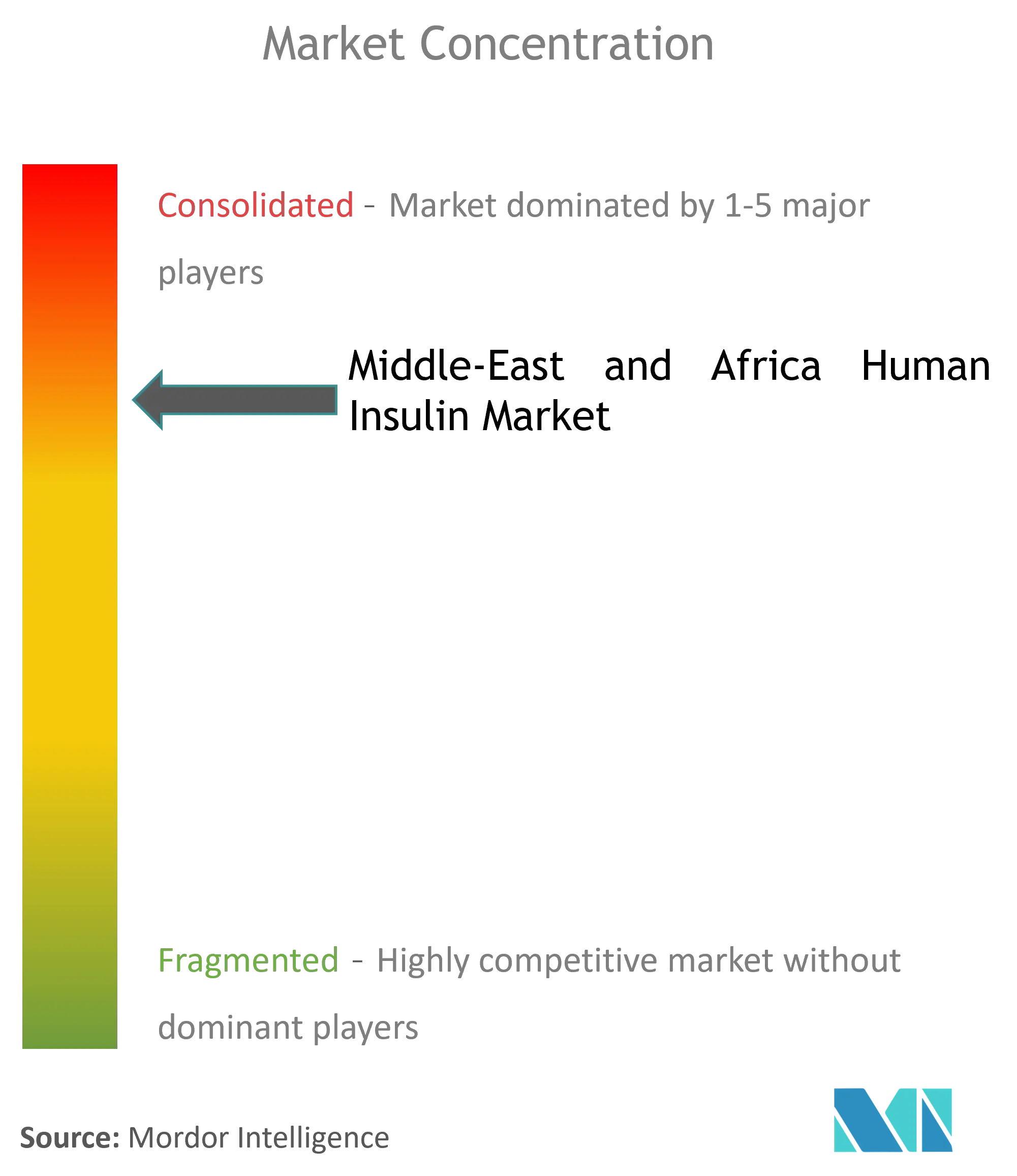
Middle East and Africa Diabetes Treatment Market News
- February 2023: South Korea-based EOFlow, a provider of wearable drug delivery solutions, received certification from the United Arab Emirate (UAE) Ministry of Health and Prevention (MOHAP) to commercialize its wearable insulin pump 'EOPatch' and its controller 'ADM' as well as its smartphone app 'Narsha'. EOFlow said that this UAE launch marks the first entry of EOPatches in the Middle East. The UAE is EOFlow's second overseas sales region after Europe. It was expected to serve as a bridgehead for exporting wearable insulin pump solutions to Middle East and North Africa (MENA) countries.
- December 2022: Eli Lilly partnered with generics maker Eva to boost insulin access in Africa. In a licensing agreement with generics drugmaker Eva Pharma of Egypt, Lilly was expected to deliver active pharmaceutical ingredients at a reduced cost for its human and analog insulin. Lilly also was expected to provide a 'pro-bono transfer' of the technology needed to formulate, fill and finish vials and cartridges.
Middle East and Africa Diabetes Treatment Market Report - Table of Contents
1. INTRODUCTION
1.1 Study Assumptions and Market Definition
1.2 Scope of the Study
2. RESEARCH METHODOLOGY
3. EXECUTIVE SUMMARY
4. MARKET DYNAMICS
4.1 Market Overview
4.2 Market Dynamics
4.2.1 Market Drivers
4.2.2 Market Restraints
4.3 Industry Attractiveness - Porter's Five Forces Analysis
4.3.1 Bargaining Power of Suppliers
4.3.2 Bargaining Power of Consumers
4.3.3 Threat of New Entrants
4.3.4 Threat of Substitute Products and Services
4.3.5 Intensity of Competitive Rivalry
5. MARKET SEGMENTATION
5.1 Product
5.1.1 Basal or Long-acting Insulins
5.1.1.1 Lantus (Insulin Glargine)
5.1.1.2 Levemir (Insulin Detemir)
5.1.1.3 Toujeo (Insulin Glargine)
5.1.1.4 Tresiba (Insulin Degludec)
5.1.1.5 Basaglar (Insulin Glargine)
5.1.2 Bolus or Fast-acting Insulins
5.1.2.1 NovoRapid/Novolog (Insulin Aspart)
5.1.2.2 Humalog (Insulin Lispro)
5.1.2.3 Apidra (Insulin Glulisine)
5.1.3 Traditional Human Insulins
5.1.3.1 Novolin/Actrapid/Insulatard
5.1.3.2 Humilin
5.1.3.3 Insuman
5.1.4 Combination Insulins
5.1.4.1 NovoMix (Biphasic Insulin Aspart)
5.1.4.2 Ryzodeg (Insulin Degludec and Insulin Aspart)
5.1.4.3 Xultophy (Insulin Degludec and Liraglutide)
5.1.4.4 Soliqua/Suliqua (Insulin glargine/Lixisenatide)
5.1.5 Biosimilar Insulins
5.1.5.1 Insulin Glargine Biosimilars
5.1.5.2 Human Insulin Biosimilars
5.2 Geography
5.2.1 Saudi Arabia
5.2.2 Iran
5.2.3 Egypt
5.2.4 Oman
5.2.5 South Africa
5.2.6 Rest of Middle East and Africa
6. MARKET INDICATORS
6.1 Type-1 Diabetes Population
6.2 Type-2 Diabetes Population
7. COMPETITIVE LANDSCAPE
7.1 Company Profiles
7.1.1 Novo Nordisk
7.1.2 Sanofi Aventis
7.1.3 Eli Lilly
7.1.4 Biocon
7.1.5 Pfizer
7.1.6 Wockhardt
7.1.7 Julphar
7.1.8 Exir
7.1.9 SEDICO
- *List Not Exhaustive
7.2 Company Share Analysis
7.2.1 Novo Nordisk AS
7.2.2 Sanofi Aventis
7.2.3 Eli Lilly and Company
7.2.4 Other Company Share Analyses
8. MARKET OPPORTUNITIES AND FUTURE TRENDS
Middle East and Africa Diabetes Treatment Industry Segmentation
Regular insulin is a kind of short-acting medical insulin, sometimes referred to as neutral insulin or soluble insulin. Type-1 diabetes, type-2 diabetes, gestational diabetes, and diabetic complications such as diabetic ketoacidosis and hyperosmolar hyperglycemic states are all treated with it. The Middle East and Africa human insulin market is segmented by product type and by geography. The report offers the value (in USD) and volume (in units) for the above segments.
| Product | |||||||
| |||||||
| |||||||
| |||||||
| |||||||
|
| Geography | |
| Saudi Arabia | |
| Iran | |
| Egypt | |
| Oman | |
| South Africa | |
| Rest of Middle East and Africa |
Middle East and Africa Diabetes Treatment Market Research FAQs
How big is the Middle East And Africa Human Insulin Market?
The Middle East And Africa Human Insulin Market size is expected to reach USD 1.62 billion in 2024 and grow at a CAGR of 3.78% to reach USD 1.95 billion by 2029.
What is the current Middle East And Africa Human Insulin Market size?
In 2024, the Middle East And Africa Human Insulin Market size is expected to reach USD 1.62 billion.
Who are the key players in Middle East And Africa Human Insulin Market?
Novo Nordisk, Sanofi, Eli lilly, Wockhardt and Pfizer are the major companies operating in the Middle East And Africa Human Insulin Market.
What years does this Middle East And Africa Human Insulin Market cover, and what was the market size in 2023?
In 2023, the Middle East And Africa Human Insulin Market size was estimated at USD 1.56 billion. The report covers the Middle East And Africa Human Insulin Market historical market size for years: 2019, 2020, 2021, 2022 and 2023. The report also forecasts the Middle East And Africa Human Insulin Market size for years: 2024, 2025, 2026, 2027, 2028 and 2029.
Middle East and Africa Diabetes Treatment Industry Report
Statistics for the 2024 Middle East and Africa Diabetes Treatment market share, size and revenue growth rate, created by Mordor Intelligence™ Industry Reports. Middle East and Africa Diabetes Treatment analysis includes a market forecast outlook to 2029 and historical overview. Get a sample of this industry analysis as a free report PDF download.
